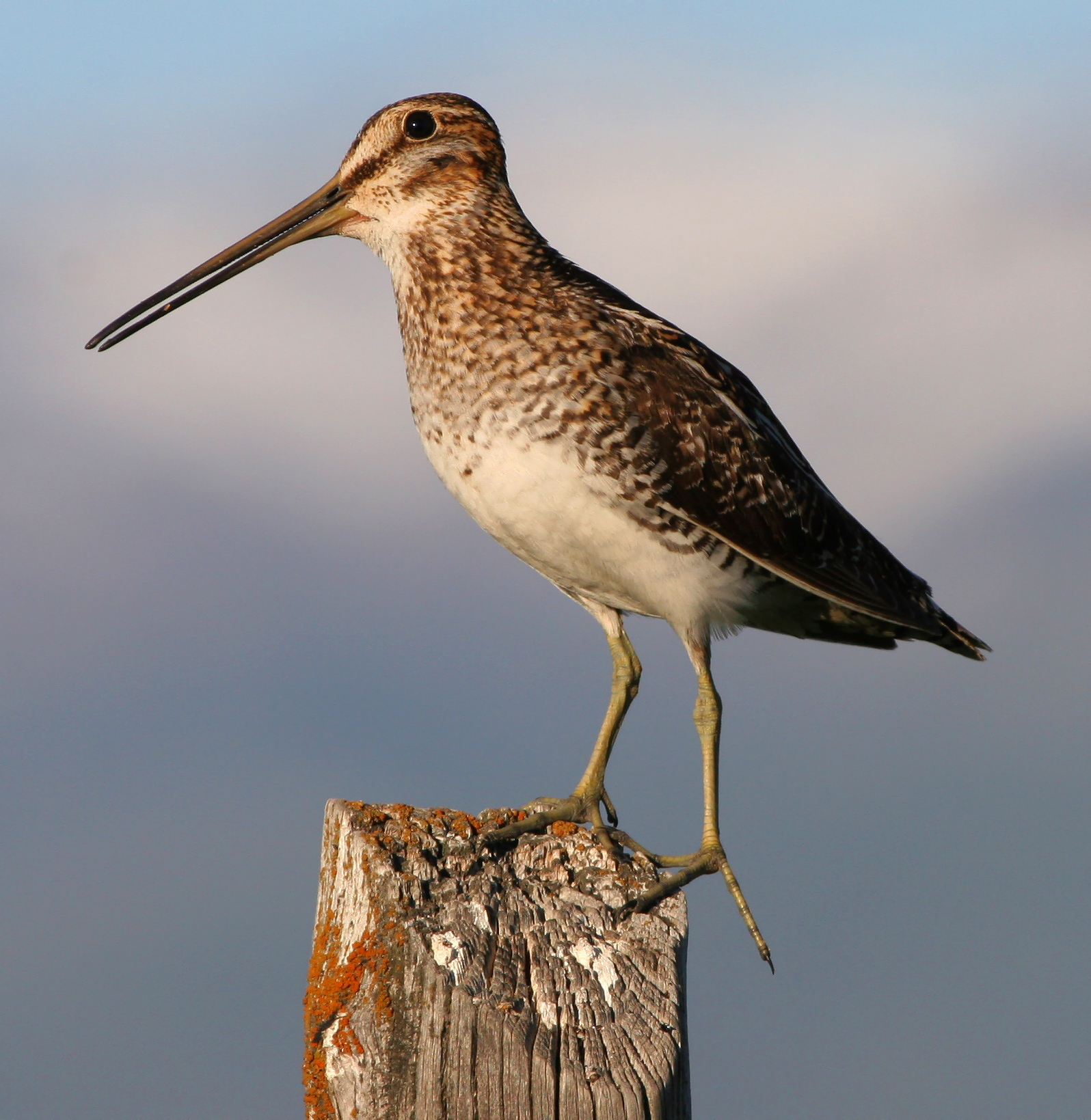- Wilson's Snipe
image_width = 220px
status = LC
status_system = iucn3.1
regnum =Animalia
phylum =Chordata
classis =Aves
subclassis =Neornithes
infraclassis =Neognathae
superordo =Neoaves
ordo =Charadriiformes
subordo = Scolopaci
familia =Scolopacidae
genus = "Gallinago "
species = "G. delicata"
binomial = "Gallinago delicata"
binomial_authority = Ord,1825
synonyms ="Gallinago gallinago delicata" Ord, 1825Wilson's Snipe ("Gallinago delicata") is a small, stocky shorebird. This
species was formerly considered to be asubspecies of theCommon Snipe , "G. gallinago". Wilson's Snipe differs from the latter species in having a narrower white edge to the wings, and eight pairs of tail feathers instead of seven.Adults are 23-28 cm in length with a 39-45 cm wingspan. They have short greenish-grey legs and a very long straight dark bill. The body is mottled brown on top and pale underneath. They have a dark stripe through the eye, with light stripes above and below it. The wings are pointed.
Their breeding
habitat ismarsh es,bog s,tundra and wet meadows inCanada and the northernUnited States . It is a year-round resident on the Pacific coast of the United States. The eastern population migrates to the southern United States and to northernSouth America . It may be thatglobal warming causes these birds to move to their breeding range earler and leave later than 100 years ago. InOhio for example, late April was recorded as an average migration date in 1906, but nowadays most of the local population is present on the breeding grounds by then already [Henninger (1906), OOS (2004)] .These birds forage in soft mud, probing or picking up food by sight. They mainly eat
insect s andearthworm s, also plant material. This well-camouflaged bird is usually shy and conceals itself close to ground vegetation and flushes only when approached closely. They fly off in a series of aerial zig-zags to confuse predators.The male performs "winnowing" display during courtship, flying high in circles and then taking shallow dives to produce a distinctive sound. They have been observed "winnowing" throughout the day and long into the night. The "winnowing" sound is similar to the call of a Boreal Owl. They nest in a well-hidden location on the ground.
The Wilson's Snipe was reduced by hunting near the end of the 19th century and
habitat destruction . However, this bird remains fairly common and not considered threatened by theIUCN . It is apparently more intolerant of habitat destruction than theAmerican Woodcock , declining markedly when faced with large-scale draining of marshland [Henninger (1906)] .Footnotes
References
*|year=2005|id=49037|title=Gallinago delicata|downloaded=12 May 2006 Database entry includes justification for why this species is of least concern
* (2000): "Birds of Ontario": 149. Lone Pine Publishing, Edmonton.
* (1906): A preliminary list of the birds of Seneca County, Ohio. "Wilson Bull." 18(2): 47-60. [http://elibrary.unm.edu/sora/Wilson/DJVU/v018n02/P0047-P0060.djvu DjVu fulltext] [http://elibrary.unm.edu/sora/Wilson/v018n02/p0047-p0060.pdf PDF fulltext]
* (2004): Annotated Ohio state checklist. Version of April 2004. [http://www.ohiobirds.org/publications/OBRClist.pdf PDF fulltext]External links
* [http://audubon-print.com/wilsons-snipe.html Wilsons Snipe by John Audubon]
* [http://www.sdakotabirds.com/species/wilsons_snipe_info.htm Wilson's Snipe Information and Photos] - South Dakota Birds and Birding
* [http://www.birds.cornell.edu/AllAboutBirds/BirdGuide/Wilsons_Snipe.html Wilson's Snipe Species Account] - Cornell Lab of Ornithology
* [http://www.bsc-eoc.org/avibase/species.jsp?lang=EN&id=47AF3A82BE808902&ts=1220251425536&sec=summary Avibase]
Wikimedia Foundation. 2010.

